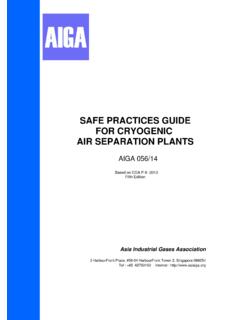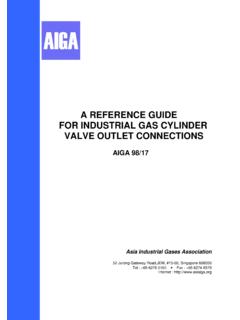Transcription of AIGA 095 16 Mechanical Integrity of Syngas outlet systems
1 Mechanical Integrity OF Syngas outlet systems AIGA 095/16 Asia Industrial Gases Association 3 HarbourFront Place, #09-04 HarbourFront Tower 2, Singapore 099254 Tel : +65 6276 0160 Fax : +65 6274 9379 Internet : Reproduced with permission from the Compressed Gas Association. All rights reserved. ASIA INDUSTRIAL GASES ASSOCIATION 3 HarbourFront Place, #09-04 HarbourFront Tower 2, Singapore 099254 Tel: +65 62760160 Fax: +65 62749379 Internet: AIGA 095/16 Mechanical Integrity OF Syngas outlet systems As part of a program of harmonization of industry standards, the Asia Industrial Gases Association has pub-lished AIGA 095, Mechanical Integrity of Syngas outlet systems , jointly produced by members of the Inter-national Harmonization Council and originally published by the Compressed Gas Association (CGA) as H-12, Mechanical Integrity of Syngas outlet systems , This publication is intended as an international harmonized standard for the worldwide use and application of all members of the Asia Industrial Gases Association (AIGA), Compressed Gas Association (CGA), Europe-an Industrial Gases Association (EIGA), and Japan Industrial and Medical Gases Association (JIMGA)
2 Each association s technical content is identical, except for regional regulatory requirements and minor changes in formatting and spelling. Disclaimer All publications of AIGA or bearing AIGA s name contain information, including Codes of Practice, safety procedures and other technical information that were obtained from sources believed by AIGA to be reliable and/ or based on technical information and experience currently available from members of AIGA and others at the date of the publication. As such, we do not make any representation or warranty nor accept any liability as to the accuracy, completeness or correctness of the information contained in these publications. While AIGA recommends that its members refer to or use its publications, such reference to or use thereof by its members or third par-ties is purely voluntary and not binding.
3 AIGA or its members make no guarantee of the results and assume no liability or responsibility in connection with the reference to or use of information or suggestions contained in AIGA s publications. AIGA has no control whatsoever as regards, performance or non performance, misinterpretation, proper or improper use of any informa-tion or suggestions contained in AIGA s publications by any person or entity (including AIGA members) and AIGA expressly disclaims any liability in connection thereto. AIGA s publications are subject to periodic review and users are cautioned to obtain the latest edition. AIGA AIGA 095/16 Contents Page 1 Introduction .. 1 2 Scope and Purpose .. 1 Scope .. 1 Purpose .. 1 3 Definitions.
4 2 4 Description of Syngas outlet systems .. 4 General description and overview .. 4 Hot outlet systems .. 5 Cold outlet systems .. 6 Materials of 8 5 Failure modes .. 9 Metal dusting .. 9 Thermal 10 Thermal 10 Creep .. 11 Excessive stress .. 11 Stress corrosion cracking .. 12 Stress relaxation cracking .. 12 High temperature hydrogen attack .. 12 Hydrogen embrittlement .. 12 Material deformation due to high temperature (bulging at hot spots) .. 13 Nitridation and carburization .. 13 Insulation failure .. 13 Summary of failure modes and components .. 14 6 Monitoring and inspection during plant operation .. 15 General and safety considerations .. 15 Visual observations .. 16 outlet system temperature monitoring .. 17 7 Online remedial action .. 18 Temperature balancing of furnace .. 18 Temperature mitigation (cooling hot spots) .. 18 8 Offline maintenance and inspection.
5 20 Hot collector (inside of furnace) and hot pigtails (inside of furnace or outside of furnace/ externally insulated) .. 20 Connection of tube to cold collector or hot collector to transition line .. 21 Refractory lined 22 9 References .. 25 Figures Figure 1 Reformer furnace with cold collector .. 5 Figure 2 Reformer furnace with hot collector .. 6 Figure 3 Cold pigtail design .. 7 Figure 4 Hot pigtail design .. 8 Figure 5 Variations in Syngas outlet pigtails .. 8 Figure 6 Example of metal dusting .. 10 Tables Table 1 Threshold temperature for creep .. 11 Table 2 Failure modes associated with Syngas outlet system components .. 15 AIGA AIGA 095/16 1 1 Introduction Large scale hydrogen production has been commercially practiced for decades and the demand for such pro-duction has grown over that period.
6 In the last several years, developments in crude oil processing, such as the increased use of hydrogen to remove sulfur and the refinement of heavier crude oil stocks, has driven signifi-cant growth in the demand for hydrogen supply. In response to this demand, industrial gas companies operate and maintain large scale hydrogen production facilities worldwide and have done so with an exemplary safety record for many years. However, it should be noted that large scale hydrogen production involves potential personnel and process safety hazards that must be addressed in design and operation. Such hazard potential is inherent to the processing of toxic and flamma-ble gases via high temperature reforming as practiced in hydrogen production. The steam reformer represents the core operating unit of most large scale hydrogen production facilities. The products from the steam reformer are collected and transferred to downstream unit operations by a collection and transfer header system .
7 The interior of the outlet system is subjected to high temperature, pressure, and hydrogen attack, while the outside is subjected to ambient conditions. The increasing severity of the service has resulted in a number of failures and therefore requires appropriate operation and maintenance. It should be noted that there are other industries, such as ammonia and methanol production, that operate large steam reformers. Therefore, it can be instructive to consider the learning and experiences from those in-dustries through organizations such as the American Institute of Chemical Engineering: Ammonia Plant Safety Symposium and the International Methanol Producers and Consumers Association (IMPCA). Steam reformer furnace design will continue to develop along with methods to implement combustion safety in these furnaces. A wide variety of steam reformer designs, configurations, and component equipment exists today.
8 Therefore, this publication includes generalized statements and recommendations on matters which there can be diversity of opinion or practice. Users of this publication should recognize that it is presented with the understanding that it can supplement, but not take the place of, sound engineering judgment, training, and experience. It does not constitute, and should not be construed to be a code or regulations. 2 Scope and Purpose Scope This publication applies to steam reformers that are operated with natural gas, refinery off gas, naphtha, and other light hydrocarbon streams. It specifically applies to large volume hydrogen production plants, defined for this publication as a nominal production capacity of 10 000 Nm3/hr (approximately 9 MMSCFD) or greater. This publication may also be applied to smaller reformers depending on the technology used. This publication may also be used for similar applications such as internally insulated piping in a partial oxida-tion unit.
9 Applicability for cases other than what is described in the publication is left to the reader. Purpose The purpose of this publication is to inform and guide interested parties on the procedures and practices relat-ed to the Mechanical Integrity of Syngas outlet systems . This publication presents a baseline for safe reformer header system operation. This publication provides a technical basis that can be used to present a common viewpoint to government and regulatory authorities, ensuring proper application of rules and regulations. AIGA AIGA 095/16 2 3 Definitions For the purpose of this publication, the following definitions apply. Publication terminology Shall Indicates that the procedure is mandatory.
10 It is used wherever the criterion for conformance to specific recom-mendations allows no deviation. Should Indicates that a procedure is recommended. May Indicates that the procedure is optional. Will Is used only to indicate the future, not a degree of requirement. Can Indicates a possibility or ability. Technical definitions Back purging Technique to protect the root side ( , opposite from the weld side) of a weld joint from oxidation by applying an inert gas or mixture such as helium, argon, or nitrogen to exclude oxygen on the root side of the weld. Boiler Closed vessel in which water is heated and steam is generated by heat input from combustible fuels in a self-contained or attached furnace. Catalyst tube Metallic alloy cylinder used to contain the catalyst in the reformer furnace. Catalyst tubes typically measure 3 in to 5 in (8 cm to 13 cm) across the inside diameter with a vertical orientation and a length spanning the height of the reformer furnace.









